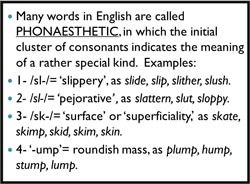The study of phonoaesthetics helps understand what makes ‘brillig’ grate the nerves, ‘lump’ appear thick, and ‘glowing’ feel light Roopa Banerjee
 When we hear the phrase ‘teeny-weeny,’ the smallness of the sound reflects its meaning. Words starting with ‘sl’ mostly feel unpleasant: slug, slush and slime. These are not coincidences and yet they haven’t been coined just for effect. The study of the aesthetic properties of sound is phonoaesthetics. This branch of phonetics studies possible connections between sounds and meanings of words.
When we hear the phrase ‘teeny-weeny,’ the smallness of the sound reflects its meaning. Words starting with ‘sl’ mostly feel unpleasant: slug, slush and slime. These are not coincidences and yet they haven’t been coined just for effect. The study of the aesthetic properties of sound is phonoaesthetics. This branch of phonetics studies possible connections between sounds and meanings of words.
The word phonoaesthetics originates from the Greek words phone (voice or sound) and aisthetike (aesthetics). To understand phonoaesthetics, we need to appreciate that sound has many qualitative aspects, of which euphony and cacophony are the most important for language experts. Euphony and cacophony use sound patterns to achieve contrasting effects. While euphony is pleasing and harmonious, cacophony is generally harsh and jarring to the ears.
Euphony is used for pleasant after-effects and is most noticed in songs or poetry such as ‘Some Sweet Day’. ‘Ode to Autumn’ by John Keats has these pleasant-sounding lines:
“Season of mists and mellow fruitfulness,
Close bosom-friend of the maturing sun…”
On the other hand, cacophonous sounds are harsh. They are unpleasantly rough and grating to the senses. “The jaws that bite, the claws that catch!” from Lewis Carroll’s Jabberwocky is one of the most famous examples of cacophony with harsh and loud sounds in invented words such as ‘brillig,’ ‘gimble,’ ‘borogoves,’ and ‘Jugjub’!
Interestingly, the Upanishads mention sound symbolism: “The mute consonants represent the earth, sibilants the sky, the vowels heaven. The mute consonants represent fire, sibilants air, vowels the sun… The mute consonants represent the eye, sibilants the ear, vowels the mind.”
Phonoaesthetics have prompted some famous stage and screen actors to change their names. Male actors try to avoid gentle continuant sounds, such as m and l, when choosing new names, and select hard-sounding consonants, such as k and g. Thus, Maurice Micklewhite became Michael Caine, Marion Michael Morrison became John Wayne and Alexander Archibald Leach became Cary Grant. Women actors went the other way by removing hard sound consonants. Thus Dorothy Kaumeyer became Dorothy Lamour and Norma Jean Baker became Marilyn Monroe.
Similarly, nicknames sound more pleasant because most of them end with ‘y’ or ‘i’ like Nicky, Billy, Jenny or Peggy. These are softer sounds and for generations, people have felt that nicknames are kinder in sound without knowing the connection with phonoaesthetics.
Combinations of letters tend to exhibit a semantic similarity. For example, the combination ‘gl’ at the beginning of words generally denotes something to do with light, whether dazzling or pale: glow, glare, gleam, glimmer, glitter, glisten, glint, gloss, gloom. The combination ‘ump’ at the end of words denotes something rounded or thick: lump, bump, clump, stump, hump, plump, and rump. These individual sound groups of letter combinations are called phonoaesthemes.
Here’s a lovely poem by American poet Alma Denny (1906-2003) which describes the connection between sound and effect of words most beautifully:
Caprice in consonants
Some words have such a lovely sound
It’s pleasant to roll them round and round
And savour their syllables on the tongue,
Words like oriole, melody, young.
Other words, though of ungraceful letter,
Harsh, abrasive,…sound even better!
These are words of intrinsic beauty,
Service, conscience, kindliness, duty.
— Alma Denny























